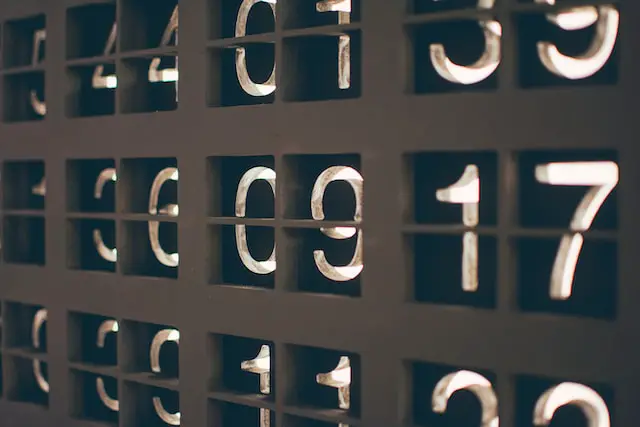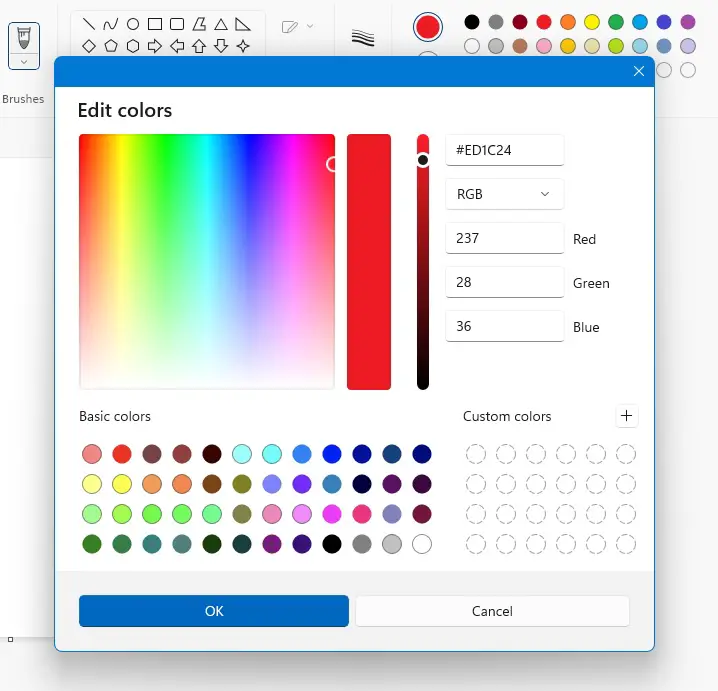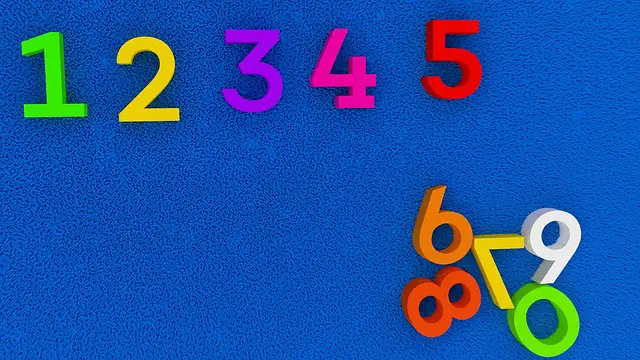Hexadecimal is a base-16 numbering system that uses 16 digits (0-9 and A-F) to represent numbers, while decimal is a base-10 numbering system that uses 10 digits (0-9) to represent numbers. Hexadecimal is commonly used in computer programming and digital electronics due to its compact representation of binary data.
What is decimal?
(Photo by Nick Hillier on Unsplash )

Decimal is the base 10 number system, which means it uses 10 digits (0-9) to represent numbers. It is the most common number system in use today and is used in everyday situations such as telling time, measuring distance, and counting money.
What is hexadecimal?
Hexadecimal is a base 16 number system that uses 16 unique symbols to represent numbers. 0-9 are used to represent the first 10 digits, and A-F are used to represent the last 6 digits. Hexadecimal is often used in computer science because it can represent every byte of data. Decimal, on the other hand, is a base 10 number system that uses 10 unique symbols to represent numbers.
What is the difference between hexadecimal and decimal?
Hexadecimal and decimal are both numbering systems, but they differ in the base they use to represent numbers.
Decimal is a base-10 numbering system that uses 10 digits (0-9) to represent numbers. Each digit in a decimal number has a place value that is a power of 10, with the rightmost digit having a place value of 1, the next digit to the left having a place value of 10, the next digit to the left having a place value of 100, and so on.
Hexadecimal, on the other hand, is a base-16 numbering system that uses 16 digits (0-9 and A-F) to represent numbers. Each digit in a hexadecimal number has a place value that is a power of 16, with the rightmost digit having a place value of 1, the next digit to the left having a place value of 16, the next digit to the left having a place value of 256, and so on.
While decimal is the most commonly used numbering system in everyday life, hexadecimal is often used in computer programming and digital electronics because it can represent a byte of data (8 bits) using two hexadecimal digits, which is more compact than using 8 binary digits (bits) or 3 decimal digits.
How to convert from decimal to hexadecimal?
To convert a decimal number to a hexadecimal number, you can use the following steps:
- Divide the decimal number by 16.
- Write down the remainder (in hexadecimal notation) as the rightmost digit of the hexadecimal number.
- Divide the quotient (integer result of the division) by 16.
- Write down the remainder as the next digit of the hexadecimal number, to the left of the previous digit.
- Repeat steps 3-4 until the quotient is zero.
For example, let’s convert the decimal number 255 to hexadecimal:
- 255 ÷ 16 = 15 remainder 15 (or F in hexadecimal notation).
- Write down F as the rightmost digit of the hexadecimal number.
- 15 ÷ 16 = 0 remainder 15.
- Write down F as the next digit to the left of the previous digit.
- Since the quotient is zero, we stop. The hexadecimal representation of 255 is FF.
- Therefore, the hexadecimal representation of 255 is FF.
How to convert from hexadecimal to decimal?
To convert a hexadecimal number to a decimal number, you can use the following steps:
- Write down the hexadecimal number.
- Assign a decimal value to each digit in the hexadecimal number, using the following table:
| HEXADECIMAL DIGIT | DECIMAL VALUE |
|---|---|
| 0 | 0 |
| 1 | 1 |
| 2 | 2 |
| 3 | 3 |
| 4 | 4 |
| 5 | 5 |
| 6 | 6 |
| 7 | 7 |
| 8 | 8 |
| 9 | 9 |
| A | 10 |
| B | 11 |
| C | 12 |
| D | 13 |
| E | 14 |
| F | 15 |
- Multiply the decimal value of each digit by 16 raised to the power of its position in the number, where the rightmost digit has a position of 0, the next digit to the left has a position of 1, and so on.
- Add up the results of all the multiplications.
For example, let’s convert the hexadecimal number FF to decimal:
- Write down FF.
- The leftmost digit F has a decimal value of 15, and the rightmost digit F also has a decimal value of 15.
- Multiply the decimal value of the leftmost digit by 16 raised to the power of 1 (the position of the digit from the right): 15 × 16^1 = 240. Multiply the decimal value of the rightmost digit by 16 raised to the power of 0: 15 × 16^0 = 15.
- Add up the results of the multiplications: 240 + 15 = 255.
Therefore, the decimal representation of the hexadecimal number FF is 255.
What is hexadecimal used for?
(Photo By Hiberty)

Hexadecimal is commonly used in computer programming and digital electronics for a variety of purposes, including:
- Representing binary data: Hexadecimal provides a compact and convenient way to represent binary data, such as machine code instructions and memory addresses, as each hexadecimal digit can represent four bits (a nibble) of binary data. For example, the binary number 11010110 can be represented as the hexadecimal number D6.
- Color representation: In digital graphics, colors are often represented using hexadecimal notation. Each color channel (red, green, and blue) is assigned a hexadecimal value from 00 to FF, representing the intensity of that color channel. For example, the color white is represented as #FFFFFF (i.e., maximum intensity of all color channels), while the color black is represented as #000000 (i.e., minimum intensity of all color channels).
- Hash codes: In computer science, cryptographic hash functions often produce output in hexadecimal format, which can be more convenient for human interpretation and comparison than the raw binary output.
- Debugging and troubleshooting: Hexadecimal notation is often used in debugging and troubleshooting computer programs, as it can help programmers and technicians to identify memory locations, data values, and other important information more easily than with decimal or binary notation.
Hexadecimal is a powerful tool for representing and manipulating binary data, and it is widely used in various fields related to computing and electronics.
What is decimals used for?
Decimals are used in many everyday applications, including:
- Money: Decimals are used to represent monetary values, such as prices, salaries, and financial transactions. For example, $1.99 represents one dollar and ninety-nine cents.
- Measurements: Decimals are used to represent measurements of length, weight, volume, and other physical quantities, such as 2.5 centimeters, 3.75 liters, and 0.5 kilograms.
- Math: Decimals are used in mathematical calculations and expressions, such as addition, subtraction, multiplication, and division, as well as in functions, graphs, and equations.
- Science: Decimals are used in scientific measurements and calculations, such as temperature, pH, and concentration, as well as in scientific notation, which is a way of expressing very large or very small numbers using powers of ten.
- Time: Decimals are used to represent time values, such as hours, minutes, and seconds, as well as fractions of a second, such as milliseconds and microseconds.
Overall, decimals are a fundamental part of our numerical system, and they are used in many areas of everyday life, from finance and science to education and technology.
How do you know if a number is hexadecimal?
To the untrained eye, decimal and hexadecimal numbers may look very similar. However, there are some key differences between the two number systems that can help you determine if a number is hexadecimal.
First, it’s important to know that the decimal number system is based on 10 and the hexadecimal number system is based on 16. This means that each digit in a hexadecimal number can represent a value from 0-15, while each digit in a decimal number can only represent a value from 0-9.
One way to tell if a number is hexadecimal is to look for the presence of the letters A-F after the first 9 digits (0-9). If these letters are present, then the number is likely hexadecimal. Another way to tell if a number is hexadecimal is to see if it’s divisible by 16 – if it is, then it’s probably hexadecimal.
Keep in mind that there are some numbers that can be expressed in both decimal and hexadecimal form (such as 255 or FF), so simply looking for the presence of A-F isn’t always foolproof. However, using both methods should give you a good idea of whether or not a number is hexadecimal.
Advantages and disadvantages of decimal and hexadecimal
Both decimal and hexadecimal number systems have advantages and disadvantages depending on the context of their use. Here are some of the advantages and disadvantages of each system:
Advantages of Decimal:
- Decimal is a familiar system to most people, as it is commonly used in everyday life for counting, measuring, and other tasks.
- Decimal is easy to understand and use for basic arithmetic operations, such as addition, subtraction, multiplication, and division.
- Decimal has a clear positional notation system, where each digit represents a value that is 10 times greater than the digit to its right.
Disadvantages of Decimal:
- Decimal is not very efficient for representing large numbers or working with binary data, as it requires more digits than hexadecimal to represent the same value.
- Decimal is not as compact or convenient as hexadecimal for representing memory addresses, machine code instructions, and other low-level computer operations.
Advantages of Hexadecimal:
- Hexadecimal is a compact and convenient system for representing binary data, as each hexadecimal digit can represent four bits of binary data.
- Hexadecimal is widely used in computer programming, digital electronics, and other technical fields, where it provides an efficient and intuitive way to work with binary data.
- Hexadecimal is easy to convert to and from binary, as each hexadecimal digit corresponds to a unique four-bit pattern.
Disadvantages of Hexadecimal:
- Hexadecimal is not as familiar or intuitive to most people as decimal, as it requires an understanding of the relationship between hexadecimal and binary.
- Hexadecimal can be more difficult to use for basic arithmetic operations, as each digit represents a value that is 16 times greater than the digit to its right.
- Hexadecimal notation can be error-prone if the digits are not clearly distinguished from each other, as some letters (such as B, D, and F) can be mistaken for digits (8, 0, and 1) if not written clearly.
Both decimal and hexadecimal have their strengths and weaknesses, and the choice between them depends on the specific needs and requirements of the task at hand.
Featured Image By – Sam Karanja from Pixabay








